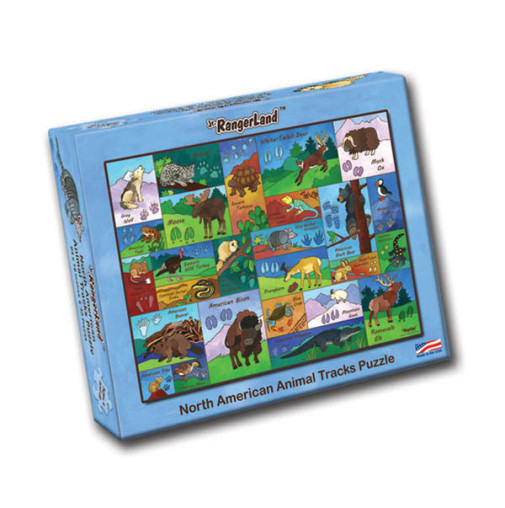We use cookies to make your experience better. To comply with the new e-Privacy directive, we need to ask for your consent to set the cookies. Learn more.
North American Animal Tracks Puzzle (250 pcs)
If your family is one who spends quality time in the wild together, learning to recognize animal tracks is a valuable skill to be learned by all ages. With colorful graphics, this 250 pc. puzzle teaches tracks and ranges of 26 common North American wildlife. A sampling of animals included is: Gray Wolf, Musk Ox, American Bison, Pronghorn, and Eastern Collard Lizard, plus many others. From the same company as the Animal Tracks Matching Game (#008787), approximately ½ the animal tracks have been repeated. Large individual pieces vary in size with the completed puzzle measuring 19" x 13". Made in the USA. ~ Deanne
Assemble this colorful puzzle and identify the tracks associated with each animal. Use the map on the back of the box to see where these animals may be found in North America. Made in the USA.
19×13 inches, 250 pieces, Ages 6+
| Product Format: | Other |
|---|---|
| Grades: | PK-3 |
| Brand: | Jr. Rangerland |
| Author: | Jennifer Haywood |
| EAN/UPC: | 808874211733 |
| Length in Inches: | 8.75 |
| Width in Inches: | 11 |
| Height in Inches: | 2.25 |
| Weight in Pounds: | 0.85 |
Rated 5 stars by 100% of reviewers
Rated 4 stars by 0% of reviewers
Rated 3 stars by 0% of reviewers
Rated 2 stars by 0% of reviewers
Rated 1 star by 0% of reviewers
- Start typing and we'll see if it was already asked and answered.
- If there aren't already some matches, submit a new question.
- You'll get fast answers from customers who really own the item(s) and from our product experts. (About half the time you'll get an answer in under 2 hours!)
- Which items will best meet your needs
- What customers who own an item think of it
- How to use, fix, or take care of an item
- Product information
- General advice related to the types of products we sell
- Our store policies
For questions about an order you have placed, please contact customer support directly.










this is for our 4 year old grand daughter
We like to teach our kids about nature
Saw at Wildlife Center
because our kids love looking for tracks in the mountains